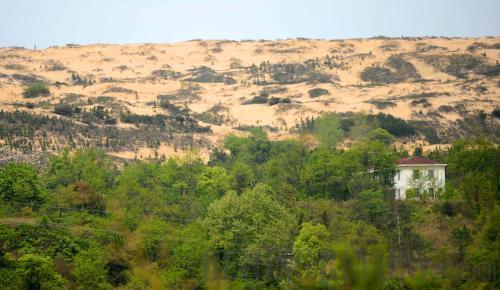|
 |
|
LOOMING DUNE: A sand hill stretches over the horizon in Duobao Township, Duchang County in Jiangxi Province (ZHOU KE) |
As water levels wane, sand at the bottom is exposed. Winds winnow sand to broader and broader areas as waters recede.
Sandified land around Poyang Lake and its tributaries accounts for an overwhelming majority of all sandified land in Jiangxi, while the remaining sandified land in the province is scattered along the Yangtze, according to Yu.
Human activities, such as improper mining, illegal logging and overgrazing, have also accelerated sandification and make it more difficult to control.
Yu said that the sandified land at the water source of the Ganjiang River, which accounts for a quarter of the total in Jiangxi, is primarily formed from human-induced soil erosion.
Local people extract rare earth with chemicals, leading to soil deterioration and loss of vegetation, Yu said. Rain water washed sand in surface soil away and deposited it into valleys.
Another type of human activity is blamed for sandification in Laohekou, located on the middle reaches of the Hanjiang River. Now, approximately 20 percent of its land is spoiled by accumulated sand.
After the Danjiangkou Reservoir, the largest man-made freshwater lake in Asia, was built on the upper middle reaches of the Hanjiang, water level in Laohekou plummeted, exposing a large part of the Hanjiang's sandy riverbed.
The Danjiangkou Reservoir is the headwater for the central route of China's ambitious plan to divert water from rivers in the wetter south to its arid north. Local authorities estimated that when the project begins diverting water northward in 2014, water levels in the Laohekou section of the Hanjiang will drop by about 1 meter.
Prevention and control
In recent years, China's arid northern provinces have made progress in harnessing desert. Southern provinces have also worked to defeat sand accumulation.
In 2005, Jiangxi set up a sandification prevention and management office under its forestry department. It has launched a series of afforestation projects, and reports sandified land decreased 3.4 percent from 2004 to 2009.
Qianshan Village in the province's Nanchang County used to have 8 hectares of sandified land. In 1999, it launched a project to combat sandification with help from experts in the provincial academy of agricultural sciences. Now the land is covered with rows of pine trees and meadows. Moreover, it produces asparagus, an economically valuable and drought-resistant crop.
Pengze declared war on sandification in the 1980s. Guided by forestry experts, farmers planted trees such as locust trees, slash pines and shrubs to protect against erosion. In 2006, the State Forestry Administration named Pengze a model county for sandification prevention and control. The county had made 82 percent of its sandified land available for cultivation again by 2012.
Despite the progress, challenges remain. Funding for Pengze's project to prevent and control sandification is not enough to meet actual demand, Yu said.
China Comments reported some southern provinces have stopped offering funds to sandification prevention and control projects.
Moreover, many people still engage in economically profitable, but ecologically damaging activities, which compromises afforestation and conservation efforts.
The ecological system of reclaimed sandified land is still fragile, and the land may be sandified again, warned Bi Liansong, Director of Pengze's Forestry Bureau.
Meteorological experts predict that by 2020, global climate change will cause temperatures in south China to rise by an average of 0.6 degrees centigrade, bring 10 percent more precipitation in the region and induce more frequent and severe droughts or floods that may accelerate erosion and spread sand even further.
Bi said that global climate change will expand sandification in the area by creating extreme weather patterns.
Email us at: wanghairong@bjreview.com | 